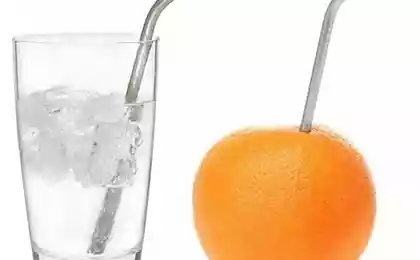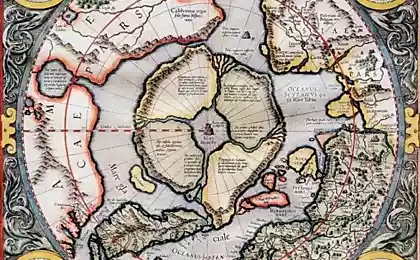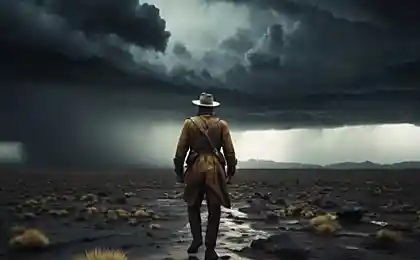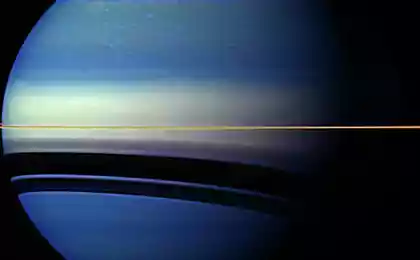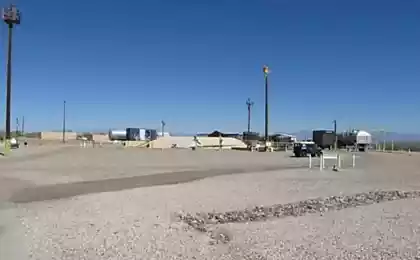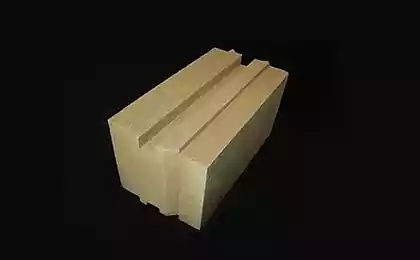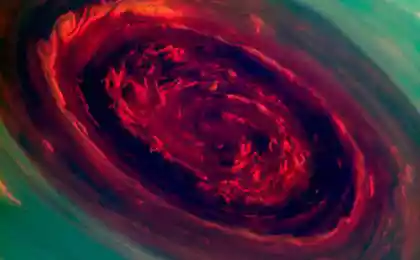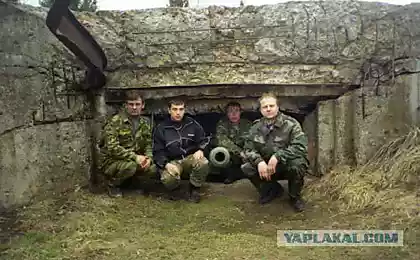840
The expedition to Titan.
Earth, Titan and the Moon on a scale
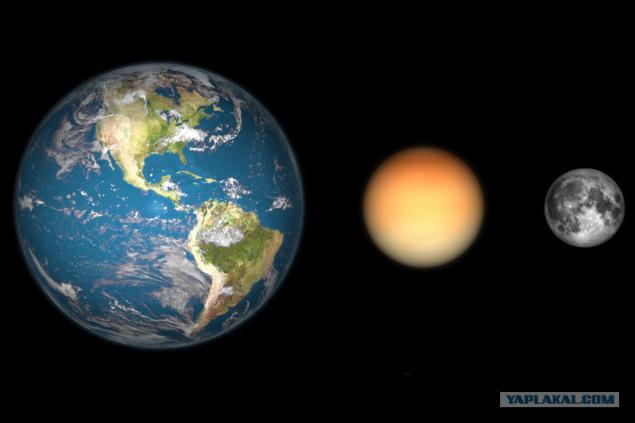
All remember that not so long ago were the publication of studies of Titan by automatic interplanetary probes and landers. Until now, this celestial body untouched by human hands. It is time to correct this unfortunate misunderstanding.
The picture of Saturn taken by its fly-around with braking on the road expedition to Titan.
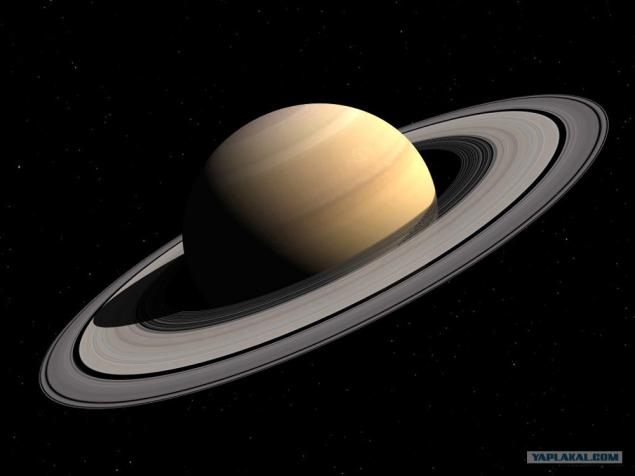
Saturn and Earth in masshtabe.- you to clearly imagine what kind of monster in an orbit which the Moon around the Earth, Titan is rotated. Like the moon, Titan Saturn constantly facing one of its side, Saturn is stationary on its skies, but the sun rises and sets on a regular basis.
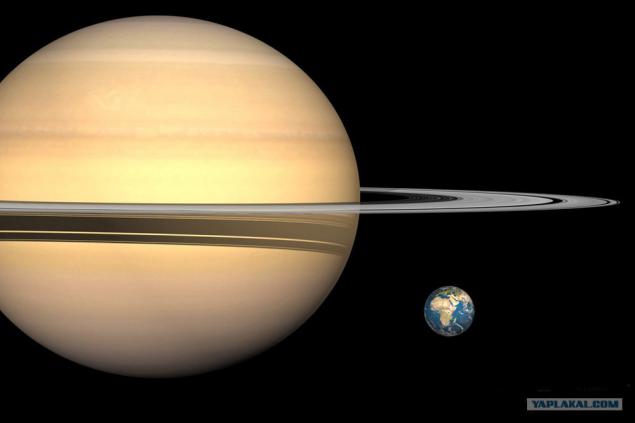
Titan, the kind while approaching to the satellite from the sun.

Against the backdrop of Saturn's Titan. The picture was taken when entering the IWC into a high orbit around Titan. The distance between celestial bodies (ie the height of the orbit of Titan) is 1,221,870 km. The presence of methane in the atmosphere leads to photolysis in the upper layers and the formation of multiple layers hydrocarbon "smog", due to which titanium is the only satellite in the solar system, the surface of which can not be observed in the optical range. Thickness Titanium atmosphere approximately 10 times greater than that of the Earth.
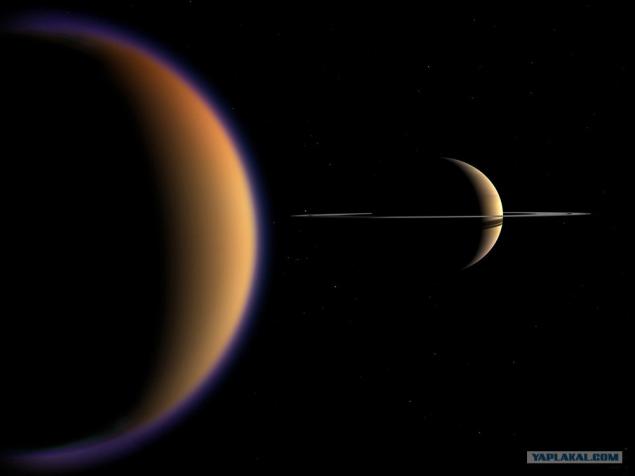
Saturn is above the upper layer of Titan's clouds. The picture was taken during landing before entering the dense cloud layer at an altitude of about 60 km above the surface of the satellite. In the plane of Saturn's rings seen four points - it's the other moons of Saturn (left to right): Enceladus, Dione, Rhea and Tethys. Orange clouds formed mist consisting of ethane, methane, nitrogen and other hydrocarbons. The atmosphere extends up another 400 km; The blue color of the sky at that altitude is due, as on Earth, nitrogen, whose share in Titan's atmosphere is 98, 6%. Apart from the above, under the presence of carbon, carbon monoxide, helium and cyano.
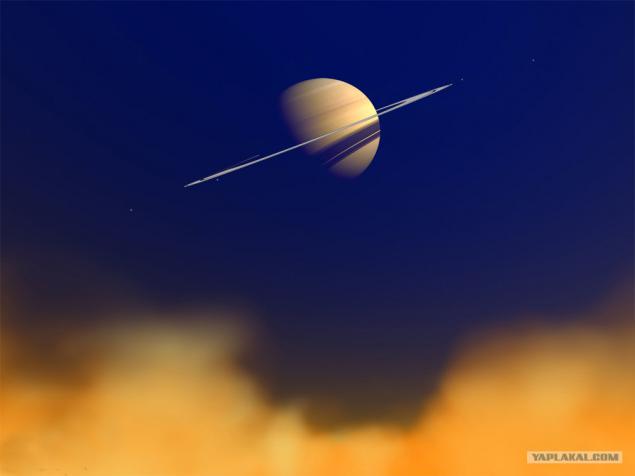
Titan from a height of 12 kilometers. Reducing the density of the surface haze allowed to see when the unit drops below 40 km; daylight on Titan resembles the Earth twilight. The dark areas on the surface - Periodic intermittent methane "lake".
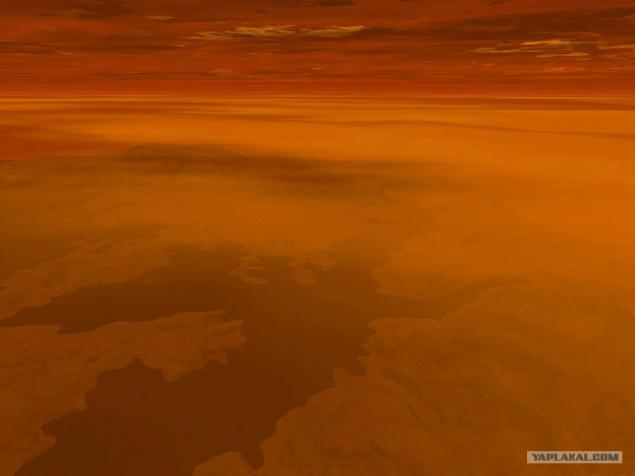
Maleny step for a man ... The first steps of people Titan. "Titanic" spacesuits look elegant vacuum: their task is not to maintain a constant internal pressure, basic functions - sealing and heating temperature overboard -180 ° C. The heating system is duplicated, and some of its most important sites even built: in case of failure in the dense atmosphere of the planet's people will turn to the ice monument to himself more quickly than in a vacuum. The pressure at the surface is twice that on Earth the same amount raised pressure inside the lander - it frees the astronauts from having to undergo lengthy decompression when returning to the ship.
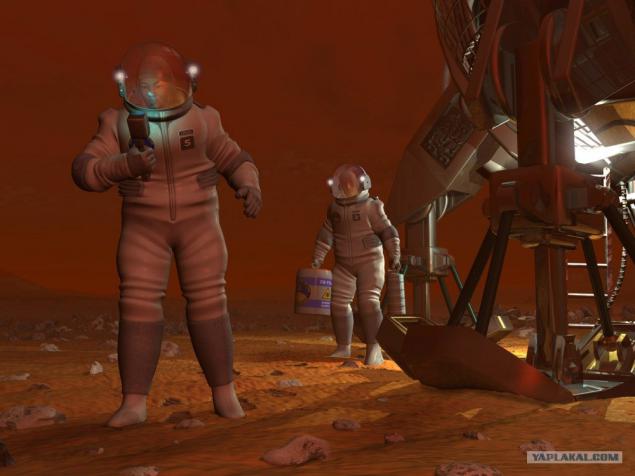
... And a huge leap for mankind. Following the first steps followed by the first jumps. Diameter of Titanium - 5152 km, it is 50% larger than the moon, with the Titanium to exceed 80% by weight of earth satellite. Titanium is also superior to the size of the planet Mercury, although inferior to her weight - this is due to the fact that part of the rock, which is composed of titanium, of ice, while the full Mercury "stone." The force of gravity on Titan is about one-seventh of the earth, and the 70-kg astronaut in the 90-kilogram suit here weighs only about 22 kg.
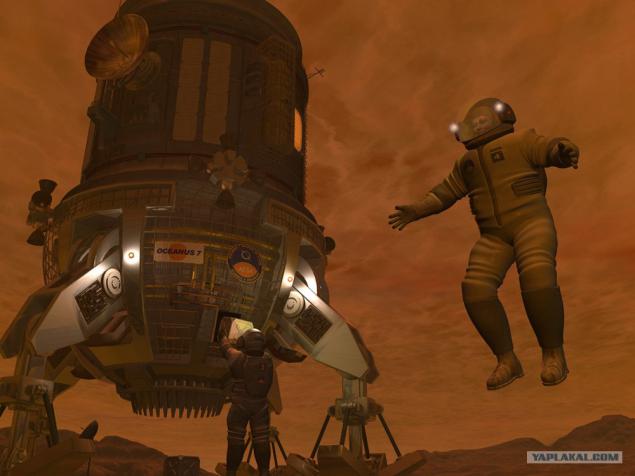
Study of dry ravine. The presence of a network of gullies has been found yet, "Huygens" in 2005. As expected, the canyon walls bear traces of fluid flow and the bottom is formed by sedimentary material. In the case of "rain" canyon may be flooded with a stream of liquid methane, so the outing is held at a constant monitoring of the weather.
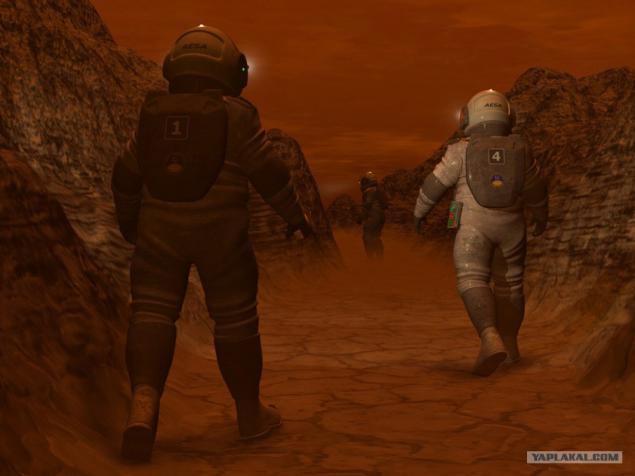
Preparation of a weather balloon in the spotlight. A complete revolution around its axis Titanium produces in 16 days, and wait for sunrise have long to work in the dark. Rover on the left, as well as all other equipment of the expedition, is capable of operating at extreme temperatures of about -200 ° C
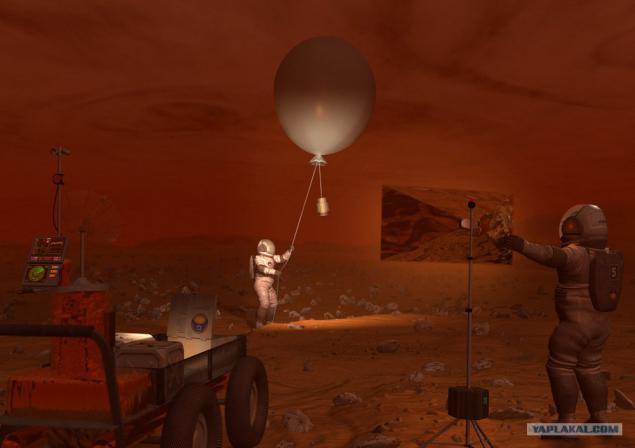
Clouds over the south pole of Titan. In contrast to Earth on Titan powerful cloud is much stronger move in latitude, as the change of seasons, while in the world, they are shifted to the north or south slightly. Titan gets too little solar energy to provide a dynamic atmospheric processes. Most likely, the energy to move air masses provide powerful tidal effects of Saturn, 400 times greater than the force of the tides caused by the Moon on the Earth.
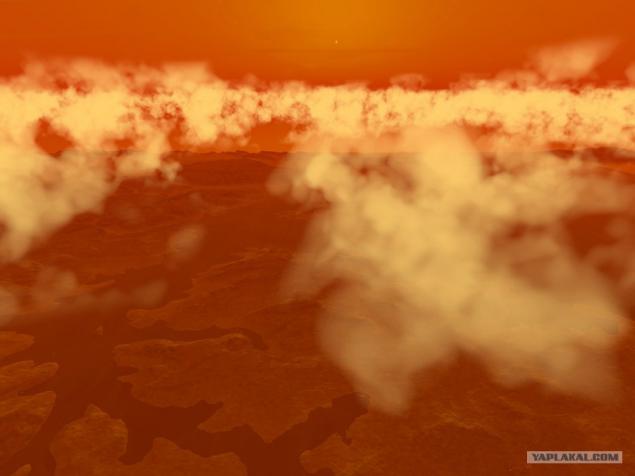
A number of modules; view from the side. Who it is still night and clouds in the background illuminated by a flash of lightning. At the surface wind is very weak (0, 3 m / s), but at altitudes of several kilometers consistently strong winds. Their velocity increases with height from a few meters per second at a height of 10-30 km to 30 m / s at a height of 50-60 km. At altitudes of more than 120 km there is a strong turbulence - its symptoms were seen more in 1980-1981. When flying through Saturn "Voyager". However, the surprise was that at an altitude of about 80 km in the atmosphere of Titan is registered calm - do not enter here or winds below 60 km, or turbulent motions observed twice. The causes of this strange zone of peace is not possible to explain.

It starts to go hydrocarbon "snow". All work on the surface of suspended - meteorologists and orbital observers warn that the snowfall intensified. Massive atmosphere with a significant amount of hydrocarbons creates the greenhouse effect, resulting in daily and seasonal temperature changes at the surface rarely exceed 2 ° C, so it can be expected that the fallen "snow" will begin to melt quickly.
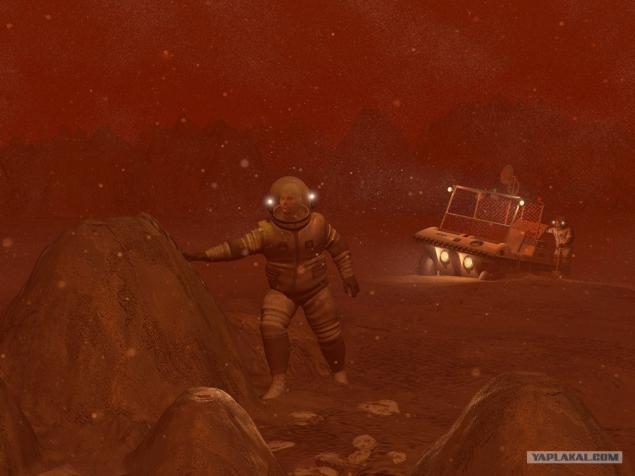
Nearing the morning; snow had stopped. As expected, the fallen "snow" has turned into streams of liquid methane-ethane mixtures and daveshny canyon was flooded.

Canyons of the river leads to the lowlands filled with alluvial deposits, where it forms extensive, long drying ethane "swamp." Application rovers or trekking expedition in places completely excluded, and they are not included in the list of tasks assigned to people. Collecting data on most of the planet's surface will be engaged in automatic machines, such as these:

Extremely cold, dense and calm atmosphere makes the surface very effective use of robots termodirizhabley. They take up little space among the expedition equipment and can move through the air over long distances, change the height and hang motionless, expending very little energy. Most of the time, these devices operate in standalone mode, in accordance with the task. The ability to report the detection of objects with predetermined parameters or abruptly, according programs differing from the surrounding areas, and then can be translated into remote control mode.
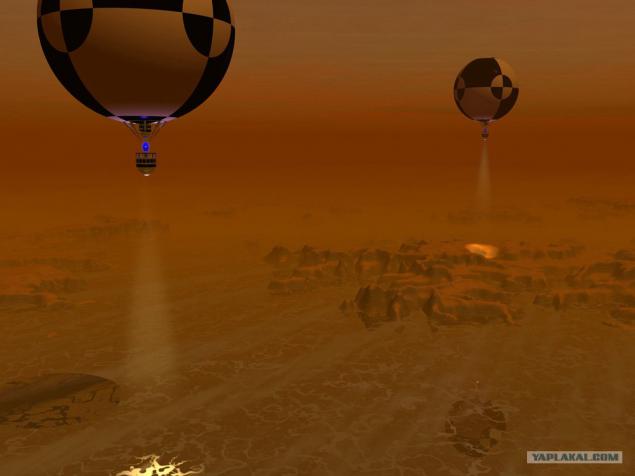
Dawn near the landing site.

The probe is "north", continuing to travel on a system of pools, shows her a picture of dawn. It turns out that Titan's surface is sometimes possible to see Saturn and the Sun (white dot above the horizon). However, this is not such a surprise - at the beginning of the XXI century was recorded glare reflected from the smooth surface of the liquid pool near the north pole of Titan, which was the first direct proof of the existence of lakes on it.
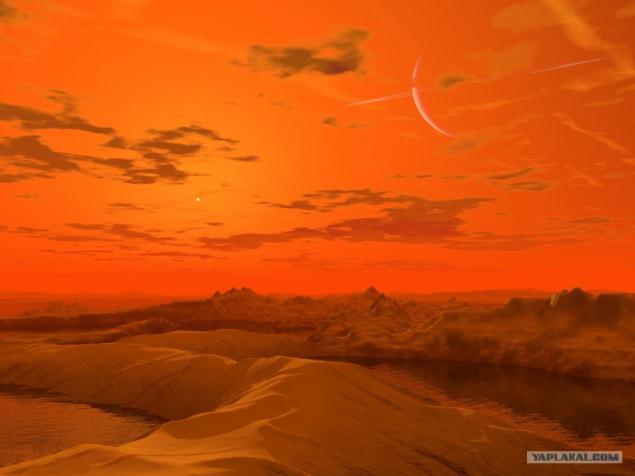
The picture with the probe "south". Near the equator of Titan are extensive areas covered with long parallel rows of dunes, stretched in the direction of prevailing winds - from west to east - for hundreds of kilometers. The sand is unusual - not a crystal, and the ice and the dark color is due to admixture of hydrocarbon dust.
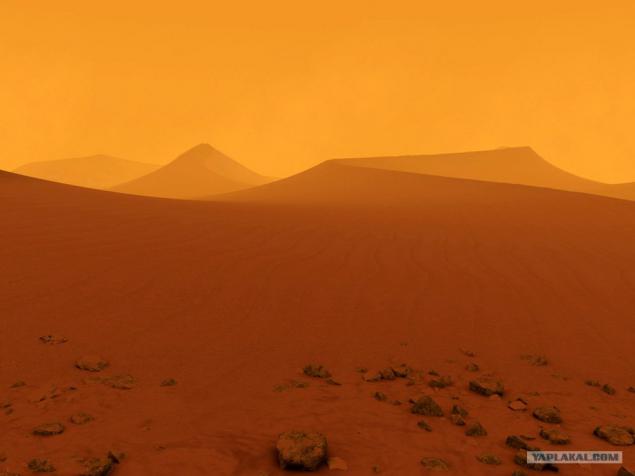
Ethane sea. The existence it became known in 2007, when the "Cassini" found near the north pole of Titan few giant lakes, the largest of which reaches a length of 1000 km and the area is comparable to the Caspian Sea, another in the area of 100 000 square kilometers is superior to any of the earth freshwater lakes. A similar orazovanie, known as Lake Ontario, was recorded near the south pole. Composition "sea water" was as follows: ethane (76-79%), propane (7-8%), methane (5-10%), 2% hydrogen cyanide, 1% of butene, butane and acetylene plus about 1% of complex organic compounds, to determine the exact composition of which probes balloon apparatus can not. Functions floating automated laboratory machines perform other expedition.
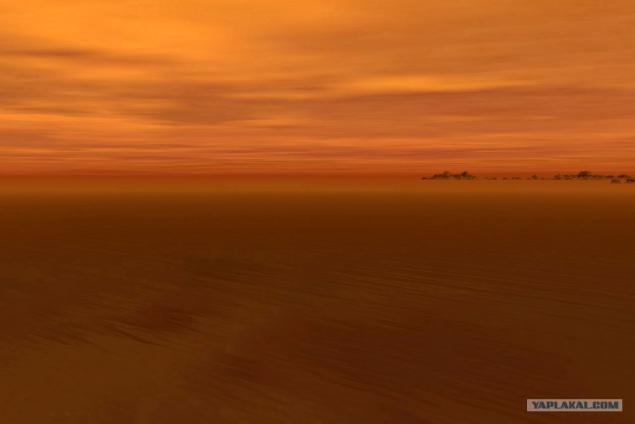
Source:

All remember that not so long ago were the publication of studies of Titan by automatic interplanetary probes and landers. Until now, this celestial body untouched by human hands. It is time to correct this unfortunate misunderstanding.
The picture of Saturn taken by its fly-around with braking on the road expedition to Titan.

Saturn and Earth in masshtabe.- you to clearly imagine what kind of monster in an orbit which the Moon around the Earth, Titan is rotated. Like the moon, Titan Saturn constantly facing one of its side, Saturn is stationary on its skies, but the sun rises and sets on a regular basis.

Titan, the kind while approaching to the satellite from the sun.

Against the backdrop of Saturn's Titan. The picture was taken when entering the IWC into a high orbit around Titan. The distance between celestial bodies (ie the height of the orbit of Titan) is 1,221,870 km. The presence of methane in the atmosphere leads to photolysis in the upper layers and the formation of multiple layers hydrocarbon "smog", due to which titanium is the only satellite in the solar system, the surface of which can not be observed in the optical range. Thickness Titanium atmosphere approximately 10 times greater than that of the Earth.

Saturn is above the upper layer of Titan's clouds. The picture was taken during landing before entering the dense cloud layer at an altitude of about 60 km above the surface of the satellite. In the plane of Saturn's rings seen four points - it's the other moons of Saturn (left to right): Enceladus, Dione, Rhea and Tethys. Orange clouds formed mist consisting of ethane, methane, nitrogen and other hydrocarbons. The atmosphere extends up another 400 km; The blue color of the sky at that altitude is due, as on Earth, nitrogen, whose share in Titan's atmosphere is 98, 6%. Apart from the above, under the presence of carbon, carbon monoxide, helium and cyano.

Titan from a height of 12 kilometers. Reducing the density of the surface haze allowed to see when the unit drops below 40 km; daylight on Titan resembles the Earth twilight. The dark areas on the surface - Periodic intermittent methane "lake".

Maleny step for a man ... The first steps of people Titan. "Titanic" spacesuits look elegant vacuum: their task is not to maintain a constant internal pressure, basic functions - sealing and heating temperature overboard -180 ° C. The heating system is duplicated, and some of its most important sites even built: in case of failure in the dense atmosphere of the planet's people will turn to the ice monument to himself more quickly than in a vacuum. The pressure at the surface is twice that on Earth the same amount raised pressure inside the lander - it frees the astronauts from having to undergo lengthy decompression when returning to the ship.

... And a huge leap for mankind. Following the first steps followed by the first jumps. Diameter of Titanium - 5152 km, it is 50% larger than the moon, with the Titanium to exceed 80% by weight of earth satellite. Titanium is also superior to the size of the planet Mercury, although inferior to her weight - this is due to the fact that part of the rock, which is composed of titanium, of ice, while the full Mercury "stone." The force of gravity on Titan is about one-seventh of the earth, and the 70-kg astronaut in the 90-kilogram suit here weighs only about 22 kg.

Study of dry ravine. The presence of a network of gullies has been found yet, "Huygens" in 2005. As expected, the canyon walls bear traces of fluid flow and the bottom is formed by sedimentary material. In the case of "rain" canyon may be flooded with a stream of liquid methane, so the outing is held at a constant monitoring of the weather.

Preparation of a weather balloon in the spotlight. A complete revolution around its axis Titanium produces in 16 days, and wait for sunrise have long to work in the dark. Rover on the left, as well as all other equipment of the expedition, is capable of operating at extreme temperatures of about -200 ° C

Clouds over the south pole of Titan. In contrast to Earth on Titan powerful cloud is much stronger move in latitude, as the change of seasons, while in the world, they are shifted to the north or south slightly. Titan gets too little solar energy to provide a dynamic atmospheric processes. Most likely, the energy to move air masses provide powerful tidal effects of Saturn, 400 times greater than the force of the tides caused by the Moon on the Earth.

A number of modules; view from the side. Who it is still night and clouds in the background illuminated by a flash of lightning. At the surface wind is very weak (0, 3 m / s), but at altitudes of several kilometers consistently strong winds. Their velocity increases with height from a few meters per second at a height of 10-30 km to 30 m / s at a height of 50-60 km. At altitudes of more than 120 km there is a strong turbulence - its symptoms were seen more in 1980-1981. When flying through Saturn "Voyager". However, the surprise was that at an altitude of about 80 km in the atmosphere of Titan is registered calm - do not enter here or winds below 60 km, or turbulent motions observed twice. The causes of this strange zone of peace is not possible to explain.

It starts to go hydrocarbon "snow". All work on the surface of suspended - meteorologists and orbital observers warn that the snowfall intensified. Massive atmosphere with a significant amount of hydrocarbons creates the greenhouse effect, resulting in daily and seasonal temperature changes at the surface rarely exceed 2 ° C, so it can be expected that the fallen "snow" will begin to melt quickly.

Nearing the morning; snow had stopped. As expected, the fallen "snow" has turned into streams of liquid methane-ethane mixtures and daveshny canyon was flooded.

Canyons of the river leads to the lowlands filled with alluvial deposits, where it forms extensive, long drying ethane "swamp." Application rovers or trekking expedition in places completely excluded, and they are not included in the list of tasks assigned to people. Collecting data on most of the planet's surface will be engaged in automatic machines, such as these:

Extremely cold, dense and calm atmosphere makes the surface very effective use of robots termodirizhabley. They take up little space among the expedition equipment and can move through the air over long distances, change the height and hang motionless, expending very little energy. Most of the time, these devices operate in standalone mode, in accordance with the task. The ability to report the detection of objects with predetermined parameters or abruptly, according programs differing from the surrounding areas, and then can be translated into remote control mode.

Dawn near the landing site.

The probe is "north", continuing to travel on a system of pools, shows her a picture of dawn. It turns out that Titan's surface is sometimes possible to see Saturn and the Sun (white dot above the horizon). However, this is not such a surprise - at the beginning of the XXI century was recorded glare reflected from the smooth surface of the liquid pool near the north pole of Titan, which was the first direct proof of the existence of lakes on it.

The picture with the probe "south". Near the equator of Titan are extensive areas covered with long parallel rows of dunes, stretched in the direction of prevailing winds - from west to east - for hundreds of kilometers. The sand is unusual - not a crystal, and the ice and the dark color is due to admixture of hydrocarbon dust.

Ethane sea. The existence it became known in 2007, when the "Cassini" found near the north pole of Titan few giant lakes, the largest of which reaches a length of 1000 km and the area is comparable to the Caspian Sea, another in the area of 100 000 square kilometers is superior to any of the earth freshwater lakes. A similar orazovanie, known as Lake Ontario, was recorded near the south pole. Composition "sea water" was as follows: ethane (76-79%), propane (7-8%), methane (5-10%), 2% hydrogen cyanide, 1% of butene, butane and acetylene plus about 1% of complex organic compounds, to determine the exact composition of which probes balloon apparatus can not. Functions floating automated laboratory machines perform other expedition.

Source:
